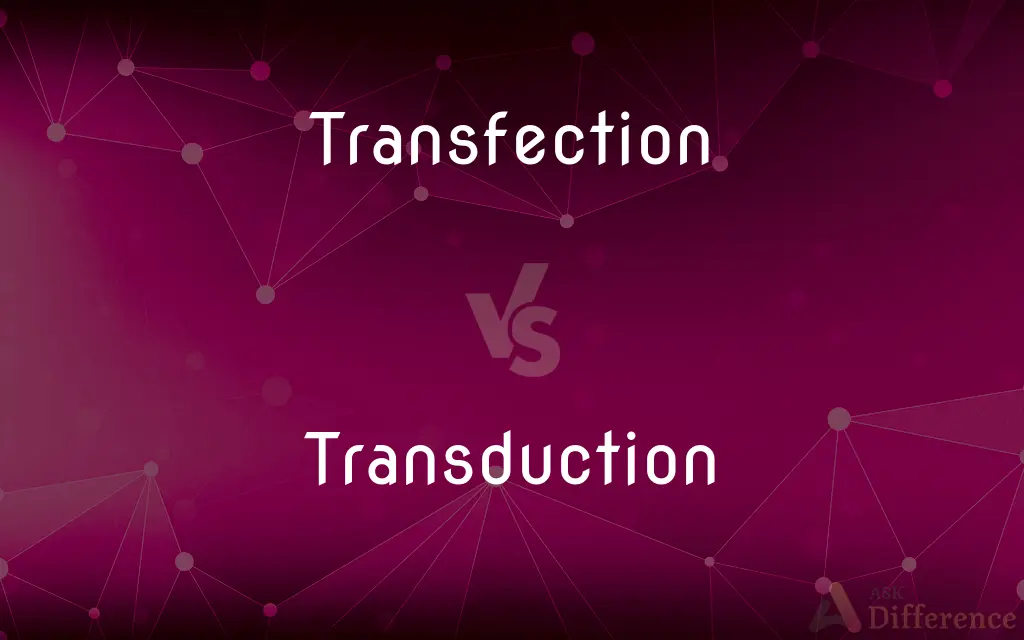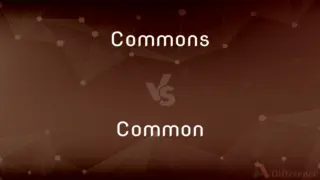Transfection vs. Transduction — What's the Difference?
Edited by Tayyaba Rehman — By Fiza Rafique — Updated on September 25, 2023
Transfection introduces foreign DNA into eukaryotic cells, while transduction uses viruses to transfer genetic material into cells. Both alter a cell's genetic makeup.

Difference Between Transfection and Transduction
Table of Contents
ADVERTISEMENT
Key Differences
Transfection and transduction are both methods used to introduce foreign genetic material into cells, but they differ in the mechanisms they employ. Transfection is the process where eukaryotic cells, particularly animal cells, are introduced with foreign DNA without using a viral vector. It's a way to express genes, produce proteins, or even modify the behavior of cells by altering their genetic content.
Transduction, on the other hand, specifically involves the use of viruses. Viruses, by nature, introduce their genetic material into host cells to replicate. Scientists harness this ability by modifying viruses to carry desired genetic material and then use them to "infect" target cells. The outcome is the successful transfer of genes without the viral replication process.
To understand the applications, consider a research lab trying to study the effects of a particular gene. By transfecting cells with this gene, they can study its function and regulation. Conversely, if the lab opts for transduction, they might use a virus to deliver the gene of interest to the cell, especially when higher efficiency is required.
Comparison Chart
Mechanism
Directly introduces foreign DNA into eukaryotic cells.
Uses viruses to transfer genetic material into cells.
Cell Type
Primarily eukaryotic cells.
Both prokaryotic and eukaryotic cells.
ADVERTISEMENT
Use of Viral Vectors
No viral vectors used.
Relies on viral vectors.
Efficiency
Generally lower than transduction.
Higher efficiency, especially in difficult-to-transfect cells.
Applications
Research, protein production, some gene therapies.
Gene therapy, specific research applications, functional genomics.
Compare with Definitions
Transfection
Does not use viral mechanisms.
Electroporation is a transfection method using electric pulses.
Transduction
Essential in many modern genetic studies.
Functional genomics relies on transduction to alter gene functions.
Transfection
A process introducing foreign DNA into eukaryotic cells.
Scientists used transfection to study gene expression.
Transduction
Can target both eukaryotic and prokaryotic cells.
Bacteriophages transduce bacterial cells.
Transfection
Primarily for eukaryotic cells.
The transfection of mammalian cells helps produce specific proteins.
Transduction
Removes harmful viral genes while retaining infectious properties.
Researchers use lentiviruses in transduction due to their safety profile.
Transfection
A non-viral gene delivery method.
The lab employed chemical transfection to introduce plasmids.
Transduction
Offers high efficiency, especially with hard-to-transfect cells.
Primary neurons often require transduction for gene delivery.
Transfection
Has various techniques, each with pros and cons.
Liposomal transfection ensures DNA delivery but has varying efficiency.
Transduction
The conversion of input energy of one form into output energy of another form.
Transfection
Transfection is the process of deliberately introducing naked or purified nucleic acids into eukaryotic cells. It may also refer to other methods and cell types, although other terms are often preferred: "transformation" is typically used to describe non-viral DNA transfer in bacteria and non-animal eukaryotic cells, including plant cells.
Transduction
See signal transduction.
Transfection
Introduction of a segment of DNA or RNA into a eukaryotic cell by means of one of a variety of physical or chemical methods or through viral infection.
Transduction
The transfer of genetic material from one cell to another, especially a bacterial cell, through the use of a bacteriophage.
Transfection
(molecular biology) The introduction of foreign genetic material (such as DNA or RNA) into a eukaryotic cell.
Transduction
(biology) The transfer of genetic material from one cell to another typically between bacterial cells, and typically via a bacteriophage or pilus.
Transduction
The process whereby a transducer converts energy from one form to another.
Transduction
(physiology) The conversion of a stimulus from one form to another.
Transduction
(physics) The conversion of energy (especially light energy) into another form, especially in a biological process such as photosynthesis or in a transducer.
Transduction
(logic) Particularly in the discipline of artificial intelligence, a form of inference, according to which the response appropriate to a particular known case, also is appropriate to another particular case diagnosed to be functionally identical. This contrasts with induction, in which general rules derived from past observations are applied to future cases as a class (compare also analogy).
Transduction
(logic design) The improvement of an electronic logic network by reduction of redundant components in an initial version, using an established pruning procedure, then applying permissible functions for transformation of the network into a workable form. Thereafter the transformation and reduction may be repeated till no worthwhile further improvement results.
Transduction
The act of conveying over.
Transduction
(genetics) the process of transfering genetic material from one cell to another by a plasmid or bacteriophage
Transduction
The process whereby a transducer accepts energy in one form and gives back related energy in a different form;
The transduction of acoustic waves into voltages by a microphone
Transduction
Transfers genetic material using viruses.
Gene therapy often uses transduction for efficient delivery.
Common Curiosities
Which method offers higher efficiency?
Generally, transduction has higher efficiency, especially in hard-to-transfect cells.
Are both transfection and transduction used for gene delivery?
Yes, both introduce foreign genetic material into cells.
Is transfection exclusive to eukaryotic cells?
Primarily, transfection targets eukaryotic cells, especially animal cells.
Are there risks associated with transduction?
Potentially, but scientists often modify viral vectors to improve safety.
Can bacteria undergo transduction?
Yes, bacteriophages (viruses that infect bacteria) can cause bacterial transduction.
Do viral vectors in transduction reproduce?
Not in therapeutic or research settings. Vectors are modified to prevent replication.
How long does gene expression last post-transfection?
It varies. Some methods give transient expression, while others can integrate DNA for longer-term expression.
Why not always use the more efficient method?
Choice between transfection and transduction depends on cell type, desired duration of expression, and other factors.
Which method uses viruses?
Transduction employs viruses to deliver genes.
Is CRISPR associated with either method?
CRISPR components can be introduced into cells via either transfection or transduction.
How is efficiency measured for these methods?
Often by the percentage of cells expressing the introduced gene or marker.
Are there non-viral transduction methods?
The term "transduction" inherently involves viruses. Non-viral methods are typically termed transfection.
Are there chemical methods for transfection?
Yes, lipid-based methods are common chemical transfection techniques.
Is transduction used in vaccines?
Some modern vaccines use viral vectors, similar in concept to transduction, to deliver antigenic information.
Do these methods affect cell viability?
Both methods can impact viability, but optimized protocols minimize this effect.
Share Your Discovery

Previous Comparison
Seminoma vs. Nonseminoma
Next Comparison
Commons vs. CommonAuthor Spotlight
Written by
Fiza RafiqueFiza Rafique is a skilled content writer at AskDifference.com, where she meticulously refines and enhances written pieces. Drawing from her vast editorial expertise, Fiza ensures clarity, accuracy, and precision in every article. Passionate about language, she continually seeks to elevate the quality of content for readers worldwide.
Edited by
Tayyaba RehmanTayyaba Rehman is a distinguished writer, currently serving as a primary contributor to askdifference.com. As a researcher in semantics and etymology, Tayyaba's passion for the complexity of languages and their distinctions has found a perfect home on the platform. Tayyaba delves into the intricacies of language, distinguishing between commonly confused words and phrases, thereby providing clarity for readers worldwide.
















































